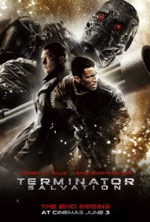Terminator: Salvation (PG-13)

Starring: Christian Bale
May 2009
“We Have Seen the Enemy and He Has a Heart”
There are a lot of firsts in Terminator: Salvation, the fourth film in the series which comes after a six year sabbatical. This is the first film in the series to feature Christian Bale in the role of adult John Connor. This is the first Terminator film not to feature Arnold Schwarzenegger, although a CG version of the original model (nude of course) goes mano a mano with Batman, uh…I mean Bale. This is the first in the series to take place exclusively in the future (except for a brief prologue which is set in 2003). Terminator: Salvation also has a new hand at the helm, McG (We Are Marshall).
Another significant addition to the new film is the abundance and variety of new Terminators, some of which look like they were leased from the Transformers franchise. The new models come in all shapes and sizes and serve a variety of purposes in the story…always at the best moment to advance the story, of course. We have modified HK’s (Hunter/Killers, as we learn from Anton Yelchin’s Kyle Reese), scout ships (which serve a similar function but are a bit larger than the mini-hunters in the Terminator 3-D ride at Universal Studios Hollywood), sleek motorcycles which pop out of the legs of a giant Terminator which looks for all the world like Megatron’s cousin, some nifty serpentine Terminators which lurk in lakes and rivers and an assortment of garden variety Terminators like the T-600. The manifold futuristic mechanizations here are reminiscent of Star Wars, especially the prequels, and the aforementioned Transformer films, which some have accused this film of copying.
All of this naturally gives rise to the question, why all the new types of Terminators? There are more new models in Terminator: Salvation than in all of the previous films combined. This does give the movie a different mood and visual style, but it smacks of the same kind of story contrivance that saw R2-D2 suddenly sprouting thrusters in Star Wars: Episode II—Attack of the Clones; the little droid possessed no such propulsion capabilities in the original trilogy. This reveals the inherent weakness of John D. Brancato and Michael Ferris’ script: everything, from one set of credits to the other, is done for the sake of convenience and expedience in order to move the plot toward a harrowing conclusion and yet another sequel. Expedience, when all is said and done, is the film’s saving grace: for all of its newfangled gimmicks and continuity paradigm shifts, the story never allows you the time to take a breath…an oft-used stratagem employed by summer blockbusters seeking to conceal their lack of story with chaotic action sequences and glossy FX.
In addition to the myriad machines, there are plenty of narrative alterations in the new film, including a centralized rebel command and the newest model of Terminator. What isn’t new here is the murky time paradox, which addles the plot with too much exposition while needlessly exasperating a broad swath of the audience with confusing timelines and genealogies when all they really want to do is sit back and enjoy a popcorn flick. It’s been a while since I’ve seen the earlier films, so the paradoxical elements of the plot are a bit fuzzy in my mind. It seems strange to me that an adult John Connor (son) could exist in the same instant of space-time as an eighteen year-old Kyle Reece (father) without the universe imploding. I’m sure Dr. Brown from the Back to the Future trilogy would have a few choice things to say on the subject.
Be that as it may, the movie contains several intriguing story elements, like: the rebel HQ on a submarine (Michael Ironsides, with his typical tough-as-nails persona, is the rigid commander), a new RF signal which could put an end to Skynet and the latest Terminator/human hybrid, Marcus Wright (played with a great deal of precision by hunky Sam Worthington). The subplot involving Marcus’ ambivalence over becoming a reformed Terminator keeps the audience guessing his loyalties until the bitter end. And is it me, or is there something about Marcus’ composition and manner that just screams Borg?
Though the plot looses focus at times, McG delivers a handful of memorable moments in the film, namely: the bridge ambush, the prison break and shootout through the mine-filled base, the serpentine Terminators attacking Connor and the entire sequence with the giant Terminator. The bridge battle reminds me of similar action sequences in True Lies (1994) and Mission Impossible III (2006), and the pulse-pounding motorcycle pursuit features a less sparse, more debris-filled roadway than the one seen in the similarly dystopian Mad Max (1979). The final battle inside Skynet, which features resistance officers and Terminators scattering in every direction like frantic stormtroopers on a doomed Death Star, is somewhat protracted and fails to deliver the kind of visceral thrills required of a blockbuster finale. The melee never quite draws us into the fight but leaves us feeling hollow over the shallow spectacle…a fitting culmination to a similarly heartless movie.
Terminator: Salvation has left the gate wide open for a sequel. It has also left us with some hope for the future, unlike each of the bleak resolutions in the earlier trilogy. I actually think the new direction for the series has potential…imagine Red Dawn (which is currently being remade) with Terminators subbing for Russians. If the guerrilla war premise catches on, it could sustain the series for a few more movies until all of the Terminators have been terminated.
Rating: 2 1/2